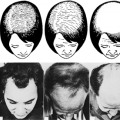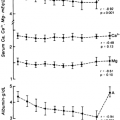POSTOPERATIVE COMPLICATIONS
Many authors have reported large series of thyroidectomies with no deaths. In other reports, mortality does not differ greatly from that due to anesthesia alone. Four major complications are associated with thyroid surgery: thyroid storm, wound hemorrhage, recurrent laryngeal nerve injury, and hypoparathyroidism.
THYROID STORM
Thyroid storm reflects an exacerbation of a thyrotoxic state and is seen most often in Graves disease, but it can occur rarely in patients with toxic adenoma or toxic multinodular goiter. Clinical manifestations and management of thyroid storm are discussed in Chapter 42.
WOUND HEMORRHAGE
Wound hemorrhage with hematoma is an uncommon complication, reported in 0.3% to 1.0% of patients in most large series. However, it is a well recognized and potentially lethal complication. A small amount of hematoma deep to the strap muscles can compress the trachea. A suction closed-drainage system placed in the wound is not adequate for decompression if bleeding is from a major vessel. Swelling of the neck and bulging of the wound can be followed shortly thereafter by respiratory impairment. Treatment consists of immediately opening the wound and evacuating the clot, even at the bedside. Later, the bleeding vessel can be ligated in a careful and leisurely manner in the operating room. The urgency of treating this condition when it occurs cannot be overemphasized.
INJURY TO THE RECURRENT LARYNGEAL NERVE
Recurrent laryngeal nerve injuries 43 occur in 1% to 2% or more of thyroid operations, especially when performed for malignant disease. The injuries can be unilateral or bilateral, temporary or permanent. Loss of function can be caused by transection, ligation, or handling of the nerve. In unilateral recurrent nerve injuries, the voice becomes husky because the vocal cords do not approximate one another. Usually vocal function returns within 6 to 9 months. If improvement is insufficient, injection of the paralyzed vocal cord with collagen may help.44 One surgery involves insertion of a plug of silicone rubber, fashioned to the correct size to push the paralyzed vocal cord to the midline and thus improve vocal function.
Stay updated, free articles. Join our Telegram channel

Full access? Get Clinical Tree





